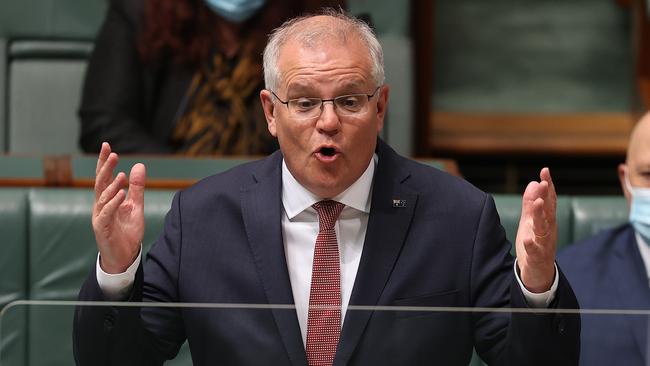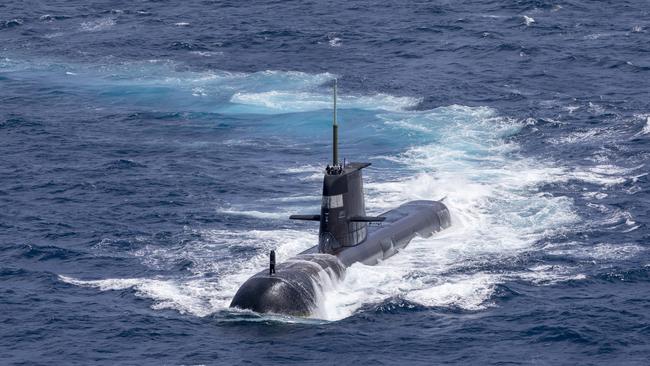Michael McGuire: Job losses at Adelaide’s Osborne shipyard show transition to nuclear subs will be tough
The prime minister’s much-hyped American nuclear submarine coup traded certain work for an 18-month study, writes Michael McGuire.
Opinion
Don't miss out on the headlines from Opinion. Followed categories will be added to My News.
Now that all the hoopla about Australia joining the nuclear submarine age is dying down, some of the implications of Scott Morrison decision to scrap the $90 billion deal to build submarines in Adelaide with French group Naval are starting to become clearer.
First and foremost was the worrying statement in federal parliament on Monday by Australian Naval Infrastructure boss Andrew Seaton that as many as 600 highly skilled South Australian jobs are now in jeopardy.
Those workers were building the new shipyard at Osborne for the 12 Attack class submarines but work stopped after the Morrison’s announcement of the AUKUS partnership with the US and UK.
More than $370 million had already been spent on the project.
So, when Morrison announced last month he was deep sixing the project with Naval he essentially drove the national shipbuilding industry into another valley of death.
Morrison axed the certainty of that work and replaced it with an 18-month feasibility study to “examine the full suite of requirements that underpin nuclear stewardship and demonstrate a clear pathway to becoming a responsible and reliable steward of this sensitive technology’’.
The PM also said: “We intend to build these submarines in Adelaide, Australia, in close co-operation with the United Kingdom and the United States.’’

Intend being the key word there. No actual commitment
Under the new nuclear deal we are promised fewer boats at a greater cost. Although we don’t know that cost yet. We don’t know what subs we will be getting, or from which country, how extensive the promised technology transfer will be, how we will build a domestic nuclear infrastructure or how much of the build will happen in Adelaide.
Some of this will obviously become clearer but it’s hard not to believe South Australia is going to be worse off as a result. The state has had a $90 billion contract removed and no one knows what it will be replaced with. It’s hard to figure out how Australia is going to build, maintain and crew a fleet of nuclear-powered subs with no domestic nuclear industry and very limited expertise in the field.
Again, it’s early days, but it’s possible the best we can hope for is to bolt the subs together, with the majority of the high-skilled design and construction work being done offshore. The worst, and probably most likely option, is that those subs will never be built in Adelaide.
And whatever work is coming to Adelaide is such a long way away.
At best, construction will start sometime in the 2030s, with boats in the water not likely until the 2040s at the earliest.
All of which means the already venerable Collins class submarines are going to be working for a lot longer than they were designed for. At another parliamentary hearing last week, chief of navy, Vice Admiral Michael Noonan said it was possible the Collins would still be operating in the 2050s. These are boats that were built in the 1990s. That’s the equivalent of us using 1960s technology today.

To get even that far, the Collins will need one, and maybe two, Life of Type Extensions, meaning they will be cut in half and rebuilt from the inside.
At a time when there’s a lot of aggressive voices talking about some kind of imminent war with China, Australia is waiting decades before its new submarines will be delivered.
The idea of either leasing nuclear-powered subs or buying second-hand subs from the US or the UK has been raised as an interim solution but both options appear longshots. Both countries are busy building new subs for their own navy and buying aged, second-hand nuclear subs with no expertise in how to run them would appear a risky proposition for Australia.
It’s a blight on both Liberal and Labor federal governments that submarine policy has been handled so badly over the last decade. Labor couldn’t make a decision, the Liberals apparently made the wrong decision.
Now we are back into the unknown and South Australian jobs, skills and businesses are being sacrificed on this altar of collective incompetence.




